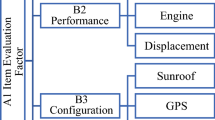Abstract
Due to the vast availability of user-generated content, social media is considered useful for businesses to track users’ reactions, preferences and change in sentiments toward a specific product. The rise of social media is transforming the way businesses operate and interact with various related stakeholders and communities tremendously. Many businesses are competing to optimize their strategies and approaches to control this amount of information. The paper presents the importance of using social media content in the new product development and shows a new way of conversational analysis to generate the preliminary findings of an ongoing study. We undertook a case study of mobile phone, Samsung Galaxy S6, and S6 Edge, using two tools (e.g., R and NodeXL) to extract and analyze the Twitter data. Further, we used content analysis and network analysis approaches to get insights based on thematic pattern and topological metrics of social networks. Our findings show that there are considerable differences in the structure of conversational patterns of the two launches durations. The insights on these patterns can be extremely enlightening about early users’ perceptions and value judgments linked with the competing products.














Similar content being viewed by others
References
Agarwal, A., Xie, B., Vovsha, I., Rambow, O., & Passonneau, R. (2011). Sentiment analysis of twitter data. In Proceedings of the workshop on languages in social media (pp. 30–38). Association for Computational Linguistics.
Allan, B. (2005). Social enterprise: Through the eyes of the consumer (prepared for the National Consumer Council). Social Enterprise Journal, 1(1), 57–77.
Aral, S., Dellarocas, C., & Godes, D. (2013). Introduction to the special issue—Social media and business transformation: A framework for research. Information Systems Research, 24(1), 3–13.
Barbosa, L., & Feng, J. (2010). Robust sentiment detection on twitter from biased and noisy data. In Proceedings of the 23rd international conference on computational linguistics: Posters (pp. 36–44). Association for Computational Linguistics.
Bharathi, S. V. (2017). Prioritizing and ranking the big data information security risk spectrum. Global Journal of Flexible Systems Management, 18(3), 183–201.
Bruns, A., & Stieglitz, S. (2013). Towards more systematic Twitter analysis: Metrics for tweeting activities. International Journal of Social Research Methodology, 16(2), 91–108.
Chae, B. K. (2015). Insights from hashtag# supplychain and Twitter Analytics: Considering Twitter and Twitter data for supply chain practice and research. International Journal of Production Economics, 165, 247–259.
Chamlertwat, W., Bhattarakosol, P., Rungkasiri, T., & Haruechaiyasak, C. (2012). Discovering consumer insight from Twitter via sentiment analysis. Journal of UCS, 18(8), 973–992.
Constantinides, E., & Fountain, S. J. (2008). Web 2.0: Conceptual foundations and marketing issues. Journal of Direct, Data and Digital Marketing Practice, 9(3), 231–244.
Culotta, A. (2010). Towards detecting influenza epidemics by analyzing Twitter messages. In Proceedings of the first workshop on social media analytics (pp. 115–122). ACM.
Culotta, A., & Cutler, J. (2016). Mining brand perceptions from Twitter social networks. Marketing Science, 35(3), 343–362.
Di Martino, S., Romano, S., Bertolotto, M., Kanhabua, N., Mazzeo, A., & Nejdl, W. (2017). Towards exploiting social networks for detecting epidemic outbreaks. Global Journal of Flexible Systems Management, 18(1), 61–71.
Fuller, J., Bartl, M., Ernst, H., & Mühlbacher, H. (2006). Community based innovation. Electronic Commerce Research, 6, 57–73.
Grover, P., & Kar, A. K. (2017). Big data analytics: A review on theoretical contributions and tools used in literature. Global Journal of Flexible Systems Management, 18(3), 203–229.
Hansen, R., & Birkinshaw, J. (2007). The innovation value chain. Harvard Business Review, 85(6), 121–135.
Hansen, D., Shneiderman, B., & Smith, M. A. (2010). Analyzing social media networks with NodeXL: Insights from a connected world. Burlington: Morgan Kaufmann.
Harrington, S., Highfield, T., & Bruns, A. (2013). More than a backchannel: Twitter and television. Participations, 10(1), 405–409.
He, W., Wu, H., Yan, G., Akula, V., & Shen, J. (2015). A novel social media competitive analytics framework with sentiment benchmarks. Information & Management, 52(7), 801–812.
He, W., & Yan, G. (2014). Mining blogs and forums to understand the use of social media in customer co-creation. The Computer Journal, 58(9), 1909–1920.
He, W., Zha, S., & Li, L. (2013). Social media competitive analysis and text mining: A case study in the pizza industry. International Journal of Information Management, 33(3), 464–472.
Heer, J., & Boyd, D. (2005). Vizster: Visualizing online social networks. In IEEE symposium on information visualization, INFOVIS 2005 (pp. 32–39). IEEE.
Hennig-Thurau, T., Malthouse, E. C., Friege, C., Gensler, S., Lobschat, L., Rangaswamy, A., et al. (2010). The impact of new media on customer relationships. Journal of Service Research, 13(3), 311–330.
Hoyer, W. D., Chandy, R., Dorotic, M., Krafft, M., & Singh, S. S. (2010). Consumer co-creation in new product development. Journal of Service Research, 13(3), 283–296.
Ivanov, A. E. (2012). The Internet‘s impact on integrated marketing communication. Procedia Economics and Finance, 3, 536–542.
Jang, H. J., Sim, J., Lee, Y., & Kwon, O. (2013). Deep sentiment analysis: Mining the causality between personality-value-attitude for analyzing business ads in social media. Expert Systems with Applications, 40, 7492–7503.
Kalampokis, E., Tambouris, E., & Tarabanis, K. (2013). Understanding the predictive power of social media. Internet Research, 23(5), 544–559.
Kaplan, A. M., & Haenlein, M. (2010). Users of the world, unite! The challenges and opportunities of Social Media. Business Horizons, 53(1), 59–68.
Kristensson, P., Matthing, J., & Johansson, N. (2008). Key strategies for the successful involvement of customers in the co-creation of new technology-based services. International Journal of Service Industry Management, 19(4), 474–491.
Kumar, A., & Sebastian, T. M. (2012). Sentiment analysis on twitter. International Journal of Computer Science Issues, 9(4), 372–378.
Kunz, W., Schmitt, B., & Meyer, A. (2011). How does perceived firm innovativeness affect the consumer? Journal of Business Research, 64(8), 816–822.
Melville, P., Sindhwani, V., & Lawrence, R. (2009). Social media analytics: Channeling the power of the blogosphere for marketing insight. Proceedings of the WIN, 1(1), 1–5.
Mladenow, A., Bauer, C., & Strauss, C. (2014). Social crowd integration in new product development: Crowdsourcing communities nourish the open innovation paradigm. Global Journal of Flexible Systems Management, 15(1), 77–86.
Moe, W. W., & Schweidel, D. A. (2011). Online product opinions: Incidence, evaluation and evolution. Marketing Science, 31(3), 372–386.
Nambisan, S. (2013). Information technology and product/service innovation: A brief assessment and some suggestions for future research. Journal of the Association for Information Systems, 14(4), 215–226.
Padmaja, S., & Fatima, S. S. (2013). Opinion mining and sentiment analysis-an assessment of peoples’ belief: A survey. International Journal of Ad hoc, Sensor & Ubiquitous Computing, 4(1), 21.
Palanisamy, R., & Foshay, N. (2013). Impact of user’s internal flexibility and participation on usage and information systems flexibility. Global Journal of Flexible Systems Management, 14(4), 195–209.
Papadopoulos, S., Kompatsiaris, Y., Vakali, A., & Spyridonos, P. (2012). Community detection in social media. Data Mining and Knowledge Discovery, 24(3), 515–554.
Rathore, A. K., & Ilavarasan, P. V. (2018). Social media and business practices. In M. Khosrow-Pour (Ed.), Encyclopedia of Information Science and Technology (4th ed., pp. 7126–7139). Hershey: IGI Global
Rathore, A. K., Ilavarasan, P. V., & Dwivedi, Y. K. (2016). Social media content and product co-creation: An emerging paradigm. Journal of Enterprise Information Management, 29(1), 7–18.
Ribarsky, W., Wang, D. X., & Dou, W. (2014). Social media analytics for competitive advantage. Computers & Graphics, 38, 328–331.
Sashi, C. M. (2012). Customer engagement, buyer-seller relationships, and social media. Management Decision, 50(2), 253–272.
Seva, R. R., Duh, H. B. L., & Helander, M. G. (2007). The marketing implications of affective product design. Applied Ergonomics, 38(6), 723–731.
Shen, Y. C., Huang, C. Y., Chu, C. H., & Liao, H. C. (2010). Virtual community loyalty: An interpersonal-interaction perspective. International Journal of Electronic Commerce, 15(1), 49–74.
Singh, A. (2013). Social media and corporate agility. Global Journal of Flexible Systems Management, 14(4), 255–260.
Sinha, V., Subramanian, K. S., Bhattacharya, S., & Chaudhary, K. (2012). The contemporary framework on social media analytics as an emerging tool for behavior informatics, HR analytics and business process. Management, Journal of Contemporary Management Issues, 17(2), 65–84.
Statista. (2017). Global number of internet users 2005–2016; Retrieved July 22, 2017, from https://www.statista.com/statistics/273018/number-of-internet-users-worldwide/.
Thelwall, M., Buckley, K., & Paltoglou, G. (2011). Sentiment in Twitter events. Journal of the Association for Information Science and Technology, 62(2), 406–418.
Treem, J. W., & Leonardi, P. M. (2013). Social media use in organizations: Exploring the affordances of visibility, editability, persistence, and association. Annals of the International Communication Association, 36(1), 143–189.
Verhoef, P. C., Beckers, S. F. M., & van Doorn, J. (2013). Understand the perils of co-creation. Harvard Business Review, 91(9), 28.
Williams, S. A., Terras, M. M., & Warwick, C. (2013). What do people study when they study Twitter? Classifying Twitter related academic papers. Journal of Documentation, 69(3), 384–410.
Yoon, S., Elhadad, N., & Bakken, S. (2013). A practical approach for content mining of Tweets. American Journal of Preventive Medicine, 45(1), 122–129.
Younis, E. M. (2015). Sentiment analysis and text mining for social media microblogs using open source tools: An empirical study. International Journal of Computer Applications, 112(5), 44–48.
Yuan, Y. C., Zhao, X., Liao, Q., & Chi, C. (2013). The use of different information and communication technologies to support knowledge sharing in organizations: From e-mail to micro-blogging. Journal of the Association for Information Science and Technology, 64(8), 1659–1670.
Zembik, M. (2014). Social media as a source of knowledge for customers and enterprises. Journal of Applied Knowledge Management, 2(2), 132–148.
Author information
Authors and Affiliations
Corresponding author
Ethics declarations
Conflict of interest
We would like to declare that there is no conflict of interest.
Rights and permissions
About this article
Cite this article
Rathore, A.K., Das, S. & Ilavarasan, P.V. Social Media Data Inputs in Product Design: Case of a Smartphone. Glob J Flex Syst Manag 19, 255–272 (2018). https://doi.org/10.1007/s40171-018-0187-7
Received:
Accepted:
Published:
Issue Date:
DOI: https://doi.org/10.1007/s40171-018-0187-7




